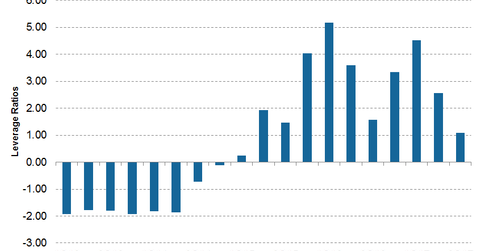Priceline’s Increasing Leverage: What You Need to Know
A large part of Priceline’s (PCLN) growth in the past has come from acquiring smaller companies all over the world. It had to raise debt to finance some of these acquisitions.
Nov. 10 2017, Updated 9:02 a.m. ET

Increasing debt
A large part of Priceline’s (PCLN) growth in the past has come from acquiring smaller companies all over the world. It had to raise debt to finance some of these acquisitions.
The increasing competition with not only online travel rivals Expedia (EXPE) and TripAdvisor (TRIP) but also big hotel chains like Marriott (MAR) and Hilton (HLT) could make it necessary for Priceline to continue to invest heavily in its business. Priceline plans to make these investments, as is evident from its recent investment in China and its plan to increase advertising expenses to combat competition.
Total debt on Priceline’s balance sheet has risen from $8.5 billion at the end of 2Q17 to $9.6 billion at the end of 3Q17. Debt was at just $7.1 billion at the end of 2016. As a result, Priceline’s leverage ratios have also increased. Its net debt-to-EBITDA (earnings before interest, tax, depreciation, and amortization) ratio has risen from 0.77x at the end of 2016 to 2.6x at the end of 2Q17. However, growth in EBITDA has helped pare down the ratio to 1.1x at the end of 3Q17.
Peer comparison
At the end of 3Q17, Expedia (EXPE) had a leverage ratio of 0.26x and China’s Ctrip International (CTRP) had a leverage ratio of 31.1x. On the other hand, TripAdvisor (TRIP) remains in a better position by virtue of having more cash than debt on its balance sheet.
Cash flow increasing
Priceline’s increasing cash flow provides respite to investors, providing confidence in Priceline’s ability to continue servicing its debt. For the first nine months of 2017, Priceline has generated $2.7 billion in cash flow from operating activities, which has translated to free cash flow of $2.5 billion for the period.
High leverage and interest costs tend to increase a stock’s volatility, especially in such an uncertain global economic environment. Investors should keep an eye on PCLN’s increasing leverage.
Investors can gain exposure to Priceline (PCLN) by investing in the PowerShares DWA Consumer Cyclicals Momentum Portfolio ETF (PEZ). Priceline has the second-highest weight in PEZ at ~4.8%.
PEZ also invests 2.6% in Expedia (EXPE). However, this ETF has no exposure to online travel stocks TripAdvisor (TRIP) and Ctrip International (CTRP).
